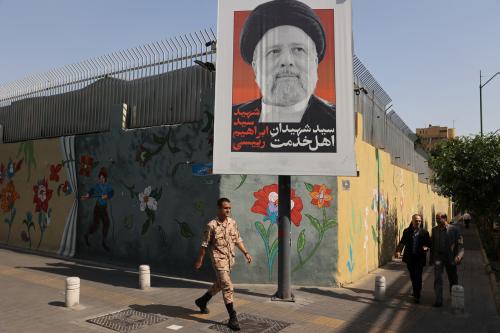Two months after the American people expressed overwhelming lack of confidence in President Bush and his war in Iraq by handing over the House and the Senate to the Democrats after twelve years of Republic control, President Bush finally admitted that strategic mistakes have been made in Iraq. In a much awaited speech he acknowledged his own responsibility for the failures in Iraq and then outlined a new strategy for ensuring the survival of Iraqi democracy.
The twenty minute speech was full of rhetoric and staid platitudes about the “burdens of freedom”, “the hope of liberty”, “the author of liberty”, the “decisive ideological struggle”, and was very thin on substance. It even had a “Borat moment” when he shared the intelligence with American people that Al Qaeda planned to establish an Islamic radical empire in the Al Anbar province of Iraq.
Indeed the new strategy outlined by President Bush had much less to offer than has been expected by experts and pundits. There was no clear plan to bring about a political solution to the Shia-Sunni divide; there was no firm commitment from the U.S. to provide economic relief to a country where unemployment is reaching 60% in many areas and there was no indication of how the US plans to regain the confidence of the Sunni population who are resisting both the new Iraqi regime and US occupation.
The plan basically has three new elements. One is a tactical shift in fighting insurgency. In the past U.S. troops would clear towns and neighborhoods and then leave allowing the insurgents to return. But now the President has made a commitment to clear and hold areas thereby preventing insurgents from returning. The additional twenty one thousand troops to be deployed are necessary for holding cleared areas.
Perhaps it has not occurred to the planners in the Pentagon that if the insurgents and sectarian fighters cannot return to their old neighborhoods in Baghdad, then they may shift their locus of operation to other cities and provinces. According to this plan by November 2007, nearly all 18 provinces in Iraq will come under Iraqi supervision, giving the fighters many options for new theaters for their activities.
The second new element in the plan is of a strategic nature and truly significant. The President has clearly indicated that unlike in the past when the US refrained from disarming Shia militias and taking actions against them, the US now intends to act against them. His exact words on this score were: “In earlier operations, political and sectarian interference prevented Iraqi and American forces from going into neighborhoods that are home to those fueling the sectarian violence. This time, Iraqi and American forces will have a green light to enter those neighborhoods — and Prime Minister Maliki has pledged that political or sectarian interference will not be tolerated.”
The promise is clear. The U.S. intends to go after Shia militias and PM Maliki will not protect them. This remains to be seen. Nouri al-Maliki’s government needs that support of the thirty seats in the Iraqi parliament that Shia militant leader Muqtada Sadr controls. If Maliki will not provide political cover for Sadr and his brigands then Sadr will not support Maliki’s government and it could collapse. It is clear that Washington is serious about this. A day before President Bush made his speech Maliki warned Muqtada Sadr’s Mahdi army to disarm or face US and Iraqi forces. The grand Ayatollah Ali al-Sistani too has expressed his support for disarmament of militias regardless of their identity. While Sistani’s influence on Iraqi politics has receded, he support is nevertheless significant.
Will the new strategy work? The chances are remote. This is clearly a case of too little too late. It also depends on many contingent factors. For example, will the Iraqi forces which are predominantly Shia act decisively against the Shia militias? Or will US troops have to face the Shia militias on their own? In the short term one can expect an immediate rise in US casualties, how long will America public be able to stomach this?
The third element of the plan is a decision to confront Iran. The President has deployed an entire carrier force to threaten Iran, deployed a battery of Patriot missiles to defend moderate allies in the region from Iranian escalation and has said that US troops will target and destroy Iranian and Syrian networks in Iraq.
The most important recommendation of the Baker-Hamilton Iraq Study group was that US should establish a dialogue with Iran and Syria and solicit their help in stabilizing Iraq. Instead of listening and acting on this wise advise, the Bush administration has once again succumbed to its neoconservative instincts, and has decided to initiate a confrontation with Iran and Syria. In a way this is an escalation and even expansion of the war in Iraq to now include Iran and Syria as targets of US military operations.
There is a major problem with this new strategy and I wonder if American policy makers realize it. With this speech President Bush has practically declared war on Shias. He has decided to go after Shia militias in Iraq, and Shia regimes in the region. Until now the US has been fighting only with the Sunnis — Al Qaeda and the Iraqi insurgency. But from now on US troops will be fighting al Qaeda, Sunni insurgents, the Mahdi and Badr militias and perhaps even Iranian and Syria intelligence and commando units.
Apparently, the Bush administration’s appetite for war and violence is not being satisfied with Afghanistan, Iraq and Somalia; it is actually seeking to open new fronts with more enemies.
This opinion has also been published in The Asian Tribune



Commentary
Op-edTo “”Save Iraqi Democracy,”” Bush’s War Will Target Shias Too
January 11, 2007